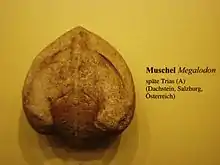Megalodon (bivalve)
Megalodon is an extinct genus of bivalve molluscs that reportedly lived from the Devonian to the Jurassic period.[1] It is not clear, however, that all the fossils assigned to Megalodon from that span of time really belong in the same genus. Jurassic relatives of Megalodon such as Pachyrisma grande were closely related to the rudists.[2]
| Megalodon | |
|---|---|
 | |
| Fossil of Megalodon | |
| Scientific classification | |
| Kingdom: | Animalia |
| Phylum: | Mollusca |
| Class: | Bivalvia |
| Subclass: | Heterodonta |
| Order: | †Megalodontida |
| Superfamily: | †Megalodontoidea |
| Family: | †Megalodontidae |
| Genus: | †Megalodon Sowerby, 1827 |
| Species | |
|
See text. | |
Species
- †Megalodon hungaricum
- †Megalodon longjiangensis
- †Megalodon rostratiforme
- †Megalodon yanceyi
- †Megalodon abbreviatus
Distribution
Fossils of the bivalve Megalodon have been found in:[1]
- Devonian
- Austria, Canada (Alberta), Germany, and Italy
- Permian
- China and Malaysia
- Triassic
- Bulgaria, Colombia, Hungary, Italy, Serbia and Montenegro and the United Arab Emirates
- Jurassic
- Italy and Morocco
References
- "Megalodon". The Paleobiology Database. Retrieved 2009-10-29.
- Skelton, Peter W. & Smith, Andrew B. (2000). "Preliminary phylogeny for rudist bivalves: sifting clades from grades". In Harper, E. M.; Taylor, J. D. & Crame, J. A. (eds.). Evolutionary Biology of the Bivalvia. Special Publication No. 177. Bath, UK: Geological Society. pp. 97–127. ISBN 1-86239-076-2.
This article is issued from Wikipedia. The text is licensed under Creative Commons - Attribution - Sharealike. Additional terms may apply for the media files.